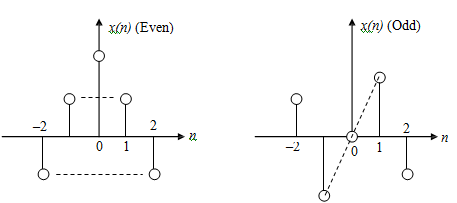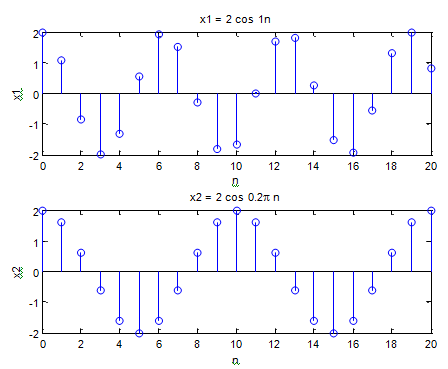Periodic signal
The discrete-time signal x(n) is periodic if, for some integer N > 0
x(n+N) = x(n) for all n
The smallest value of N which is appropriate for this relation is (fundamental) period of the signal. If there is no integer N of this type, then x(n) is an aperiodic signal.
Given that the continuous-time signal xa(t) is periodic, that is, xa(t) = xa(t+T0) for all t, and that x(n) is obtained by sampling xa(t) at T second intervals, x(n) will be periodic if T0/T is a rational number but not otherwise. If T0/T = N/L for integers N ≥ 1 and L ≥ 1 then x(n) has exactly N samples in L periods of xa(t) and x(n) is periodic with period N.
Periodicity of sinusoidal sequences The sinusoidal sequence sin (2πf0n) has many major differences from the continuous-time sinusoid which are as follows:
a) The sinusoid x(n) = sin (2πf0n) or sin (ω0n) is periodic in nature if f0, which means that, ω0/2π, is rational. If f0 is not rational sequence is not periodic in nature. By replacing n with (n+N) we get the following result
x(n+N) = sin (2πf0 (n+N)) = sin 2πf0n. cos 2πf0N + cos 2πf0n. sin 2πf0N
Visibly x(n+N) will be equal to x(n) if f0N = m, an integer or f0 = m/N. The fundamental period can be obtained by choosing m as the smallest integer which yields an integer value for N. For instance, if f0 = 15/25, the reduced fraction form of which is 3/5, then we can select m = 3 and obtain N = 5 as the period. If f0 is rational in nature then f0 = p/q here q and p are integers. If p/q is in the reduced fraction form then q is period as shown in the above example.
Conversely if f0 is irrational, say f0 = √2 , then N will not be an integer, and therefore x(n) is aperiodic.
Note: In expressions such as sin 2pfn , sinωn , and e jω n we shall refer to ω or f as the e jω n
frequency even when signal concerned to this is not periodic by the definition above.
b) The sinusoidal sequences sin ω0n and sin ((ω0+2Πk)n) for 0 ≤ ω0 ≤ 2π are similar. This can be shown by using the identity
sin ((ω0+2πk)n) = sin (ω0n+2πkn)
= sin ω0n cos 2πkn + cos ω0n sin 2πkn
Likewise, cos ω0n and cos ((ω0+2πk)n) are same. Thus in considering sinusoidal sequences for the purposes of analysis, ω0 can be restricted to range 0 ≤ ω0 ≤ π without any loss of generality.
c) For π < ω0 < 2π, based on same trigonometric identities,
sin ω0n is negative of sin ((2π-ω0)n), and
cos ω0n is same as cos ((2π-ω0)n)
The sum of 2 discrete-time periodic sequences is also periodic in nature. Let x(n) be the sum of 2 periodic sequences, x1(n) and x2(n), having periods N1 and N2 respectively. Let p and q be 2 integers so that
pN1 = qN2 = N (p and q can always be found)
Then x(n) is periodic with the period N, for all n,
x(n+N) = x1(n+N) + x2(n+N)
= x1(n+pN1) + x2(n+qN2)
= x1(n) + x2(n)
= x(n) for all n
Odd and even sequences The signal x(n) is the even sequence if x(n) = x(-n) for all n, and is an odd sequence if x(n) = -x(-n) for all n.

The even part of x(n) is determined as xe(n) =  and the odd part of x(n) is given by
and the odd part of x(n) is given by  . The signal x(n) then can be given by x(n) = xe(n) + x0(n)
. The signal x(n) then can be given by x(n) = xe(n) + x0(n)
Example: Plot sequences x1(n) = 2 cos n and x2(n) = 2 cos (0.2πn). What are their frequencies? Which is truly periodic out of them and what is periodicity of it?
Solution The MATLAB program segment is as follows:
N = 21; n = 0: N-1;
%
%Nonperiodic x1= 2*cos(1*n);
subplot(2, 1, 1), stem(n, x1);
xlabel('n'), ylabel('x1'); title('x1 = 2 cos 1n');
%
%Periodic
x2 = 2*cos(0.2*pi*n);
subplot(2, 1, 2), stem(n, x2);
xlabel('n'), ylabel('x2'); title('x2 = 2 cos 0.2\pi n');

Email based Periodic signal assignment help - Periodic signal homework help at Expertsmind
Are you finding answers for Periodic signal based questions? Ask Periodic signal questions and get answers from qualified and experienced Digital signal processing tutors anytime from anywhere 24x7. We at www.expertsmind.com offer Periodic signal assignment help -Periodic signal homework help and Digital signal processing problem's solution with step by step procedure.
Why Expertsmind for Digital signal processing assignment help service
1. higher degree holder and experienced tutors
2. Punctuality and responsibility of work
3. Quality solution with 100% plagiarism free answers
4. On Time Delivery
5. Privacy of information and details
6. Excellence in solving Digital signal processing queries in excels and word format.
7. Best tutoring assistance 24x7 hours